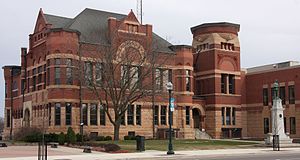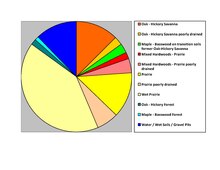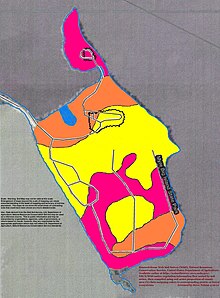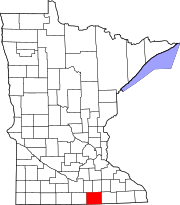Freeborn County, Minnesota
Freeborn County | |
|---|---|
U.S. county | |
 Freeborn County Courthouse | |
 Location within the U.S. state of Minnesota | |
 Minnesota's location within the U.S. | |
| Coordinates: 43°40′N 93°21′W / 43.67°N 93.35°W | |
| Country | |
| State | |
| Founded | February 20, 1855[1] |
| Named for | William Freeborn |
| Seat | Albert Lea |
| Largest city | Albert Lea |
| Area | |
| • Total | 722 sq mi (1,870 km2) |
| • Land | 707 sq mi (1,830 km2) |
| • Water | 15 sq mi (40 km2) 2.1%% |
| Population (2020) | |
| • Total | 30,895 |
| • Density | 43.7/sq mi (16.9/km2) |
| Time zone | UTC−6 (Central) |
| • Summer (DST) | UTC−5 (CDT) |
| Congressional district | 1st |
| Website | www |
Freeborn County is a county in the state of Minnesota. As of the 2020 United States Census, the population was 30,895.[2] Its county seat is Albert Lea.[3]
Freeborn County comprises the Albert Lea Micropolitan Statistical Area.
History[]
Freeborn County was created on February 20, 1855, the territory being separated from Blue Earth and Rice Counties. Twelve other Minnesota counties were created the same day by the Minnesota Territorial Legislature.[4] Freeborn County was named for William Freeborn, an early Minnesota pioneer, merchant, and territorial legislator.[5]
Geography[]
Freeborn County lies on Minnesota's border with Iowa. The Shell Rock River flows southward from Albert Lea Lake in central Freeborn County, crossing into Iowa. Turtle Creek flows eastward through the upper eastern part of the county, crossing into Mower County. The terrain is hilly and etched with drainages and gullies. The Le Sueur River, a tributary of the Minnesota River, begins in the northern part of the county and flows northward into Waseca County. The Cobb River and the Maple River, two other small rivers, begin in the extreme northwest corner of the county, the Cobb from Freeborn Lake and the Maple from Both run generally northwest, emptying into the LeSueur River, just upstream from where the LeSueur empties into the Minnesota River, on the western edge of Most of the available land is devoted to agriculture.[6] The terrain generally slopes to the south and east, although the highest point is near the northeast corner, at 1,296' (395m) ASL.[7] The county has an area of 722 square miles (1,870 km2), of which 707 square miles (1,830 km2) is land and 15 square miles (39 km2) (2.1%) is water.[8]


Lakes[6][]
- Albert Lea Lake
- Bear Lake
- Church Lake
- Everhart Lake
- Fountain Lake
- Freeborn Lake
- Geneva Lake
- Goose Lake
- Halls Lake
- Hickory Lake
- Lower Twin Lake
- Penny Lake
- Pickerel Lake
- School Section Lake
- State Line Lake
- Sugar Lake
- Trenton Lake (part)
- Upper Twin Lake
- White Lake
Protected areas[6][]
- Bear Lake State Wildlife Management Area
- Carex State Wildlife Management Area
- Halls Lake State Wildlife Area
- Moscow State Game Refuge
- Myre-Big Island State Park
- White Woods County Park
Major highways[]
Adjacent counties[]
- Steele County - northeast
- Mower County - east
- Worth County, Iowa - south
- Winnebago County, Iowa - southwest
- Faribault County - west
- Waseca County - northwest
Demographics[]
| Historical population | |||
|---|---|---|---|
| Census | Pop. | %± | |
| 1860 | 3,367 | — | |
| 1870 | 10,578 | 214.2% | |
| 1880 | 16,069 | 51.9% | |
| 1890 | 17,962 | 11.8% | |
| 1900 | 21,838 | 21.6% | |
| 1910 | 22,282 | 2.0% | |
| 1920 | 24,692 | 10.8% | |
| 1930 | 28,741 | 16.4% | |
| 1940 | 31,780 | 10.6% | |
| 1950 | 34,517 | 8.6% | |
| 1960 | 37,891 | 9.8% | |
| 1970 | 38,064 | 0.5% | |
| 1980 | 36,329 | −4.6% | |
| 1990 | 33,060 | −9.0% | |
| 2000 | 32,584 | −1.4% | |
| 2010 | 31,255 | −4.1% | |
| 2020 | 30,895 | −1.2% | |
| US Decennial Census[10] 1790-1960[11] 1900-1990[12] 1990-2000[13] 2010-2020[2] | |||

2000 census[]
As of the 2000 United States Census, there were 32,584 people, 13,356 households, and 9,015 families in the county. The population density was 46.1/sqmi (17.8/km2). There were 13,996 housing units at an average density of 19.8/sqmi (7.64/km2). The racial makeup of the county was 95.22% White, 0.24% Black or African American, 0.20% Native American, 0.55% Asian, 0.02% Pacific Islander, 2.92% from other races, and 0.85% from two or more races. 6.29% of the population were Hispanic or Latino of any race. 34.8% were of Norwegian, 26.2% German and 5.8% Danish ancestry.
There were 13,356 households, of which 29.1% had children under age 18 living with them, 56.5% were married couples living together, 7.5% had a female householder with no husband present, and 32.5% were non-families. 28.2% of all households were made up of individuals, and 14.0% had someone living alone who was 65 or older. The average household size was 2.40 and the average family size was 2.92.
The county population contained 24.0% under 18, 7.5% from 18 to 24, 25.5% from 25 to 44, 24.1% from 45 to 64, and 18.9% who were 65 or older. The median age was 40. For every 100 females there were 96.6 males. For every 100 females 18 and older, there were 95.0 males.
The median income for a household in the county was $36,964, and the median income for a family was $45,142. Males had a median income of $31,491 versus $21,799 for females. The per capita income for the county was $18,325. About 5.6% of families and 8.4% of the population were below the poverty line, including 9.0% of those under 18 and 9.1% of those over 64.
Communities[]
Cities[]
Unincorporated communities[]
- Armstrong
- Corning (partial)
- Gordonsville
- Mansfield
- Maple Island
- Moscow
- Oakland
- Petran
Townships[]
- Albert Lea Township
- Alden Township
- Bancroft Township
- Bath Township
- Carlston Township
- Freeborn Township
- Freeman Township
- Geneva Township
- Hartland Township
- Hayward Township
- London Township
- Manchester Township
- Mansfield Township
- Moscow Township
- Newry Township
- Nunda Township
- Oakland Township
- Pickerel Lake Township
- Riceland Township
- Shell Rock Township
Government and politics[]
| Year | Republican | Democratic | Third parties |
|---|---|---|---|
| 2020 | 57.0% 9,578 | 41.0% 6,889 | 2.1% 351 |
| 2016 | 54.9% 8,808 | 37.6% 6,041 | 7.5% 1,202 |
| 2012 | 41.7% 6,969 | 55.8% 9,326 | 2.5% 411 |
| 2008 | 40.3% 6,955 | 57.4% 9,915 | 2.4% 410 |
| 2004 | 43.5% 7,681 | 55.1% 9,733 | 1.4% 252 |
| 2000 | 42.4% 6,843 | 52.8% 8,514 | 4.9% 782 |
| 1996 | 32.3% 5,166 | 52.9% 8,458 | 14.8% 2,364 |
| 1992 | 28.6% 5,089 | 43.6% 7,759 | 27.9% 4,965 |
| 1988 | 44.6% 7,226 | 54.5% 8,836 | 1.0% 156 |
| 1984 | 47.1% 8,413 | 52.3% 9,338 | 0.7% 116 |
| 1980 | 47.7% 8,475 | 46.2% 8,212 | 6.2% 1,098 |
| 1976 | 45.6% 8,220 | 52.6% 9,470 | 1.8% 328 |
| 1972 | 56.9% 9,747 | 41.8% 7,163 | 1.3% 220 |
| 1968 | 44.2% 7,315 | 52.4% 8,671 | 3.5% 577 |
| 1964 | 36.7% 6,136 | 63.2% 10,554 | 0.1% 19 |
| 1960 | 52.7% 8,970 | 47.1% 8,018 | 0.1% 22 |
| 1956 | 51.6% 7,632 | 48.3% 7,138 | 0.1% 11 |
| 1952 | 56.3% 8,450 | 43.4% 6,525 | 0.3% 46 |
| 1948 | 39.5% 5,238 | 58.9% 7,825 | 1.6% 213 |
| 1944 | 46.8% 5,728 | 53.0% 6,486 | 0.3% 32 |
| 1940 | 48.9% 6,683 | 50.8% 6,942 | 0.4% 55 |
| 1936 | 37.8% 4,653 | 60.0% 7,378 | 2.2% 274 |
| 1932 | 44.6% 4,931 | 52.8% 5,838 | 2.6% 283 |
| 1928 | 72.7% 7,815 | 26.6% 2,859 | 0.7% 76 |
| 1924 | 63.8% 6,139 | 5.0% 480 | 31.3% 3,011 |
| 1920 | 82.0% 6,772 | 13.7% 1,131 | 4.4% 360 |
| 1916 | 60.1% 2,418 | 33.5% 1,347 | 6.5% 260 |
| 1912 | 17.0% 672 | 22.3% 880 | 60.7% 2,392 |
| 1908 | 61.1% 2,465 | 24.2% 976 | 14.7% 591 |
| 1904 | 78.2% 2,876 | 12.5% 461 | 9.3% 341 |
| 1900 | 74.2% 2,934 | 21.2% 838 | 4.7% 184 |
| 1896 | 72.3% 3,400 | 25.1% 1,179 | 2.7% 127 |
| 1892 | 61.3% 2,004 | 22.7% 743 | 16.0% 524 |
| Position | Name | District | Next Election | |
|---|---|---|---|---|
| Commissioner | Brad Edwin | District 1 | 2024 | |
| Commissioner and Vice Chair | Dan Belshan | District 2 | 2022 | |
| Commissioner | John Forman | District 3 | 2024 | |
| Commissioner and Chair | Christopher Shoff | District 4 | 2022 | |
| Commissioner | Ted Herman | District 5 | 2024 | |
| Position | Name | Affiliation | District | |
|---|---|---|---|---|
| Senate | Gene Dornink[16] | Republican | District 27 | |
| House of Representatives | Peggy Bennett[17] | Republican | District 27A | |
| House of Representatives | Patricia Mueller[18] | Republican | District 27B | |
| Position | Name | Affiliation | District | |
|---|---|---|---|---|
| House of Representatives | Jim Hagedorn[19] | Republican | 1st | |
| Senate | Amy Klobuchar[20] | Democrat | N/A | |
| Senate | Tina Smith[21] | Democrat | N/A | |
See also[]
- National Register of Historic Places listings in Freeborn County, Minnesota
References[]
- ^ "Minnesota Place Names". Minnesota Historical Society. Archived from the original on June 20, 2012. Retrieved March 18, 2014.
- ^ a b "U.S. Census Bureau QuickFacts: Freeborn County, Minnesota". www.census.gov. United States Census Bureau. Retrieved August 17, 2021.
- ^ "Find a County". National Association of Counties. Archived from the original on May 31, 2011. Retrieved June 7, 2011.
- ^ Upham, Warren (1920). Minnesota Geographic Names: Their Origin and Historic Significance. Minnesota Historical Society. p. 198.
- ^ Gannett, Henry (1905). The Origin of Certain Place Names in the United States. Govt. Print. Off. p. 131.
- ^ a b c Freeborn County MN Google Maps (accessed March 8, 2019)
- ^ "Find an Altitude/Freeborn County MN" Google Maps (accessed March 8, 2019)
- ^ "2010 Census Gazetteer Files". US Census Bureau. August 22, 2012. Archived from the original on October 6, 2014. Retrieved October 15, 2014.
- ^ Nelson, Steven (2011). Savanna Soils of Minnesota. Minnesota: Self. pp 43–48. ISBN 978-0-615-50320-2
- ^ "US Decennial Census". US Census Bureau. Archived from the original on April 26, 2015. Retrieved October 15, 2014.
- ^ "Historical Census Browser". University of Virginia Library. Retrieved October 15, 2014.
- ^ "Population of Counties by Decennial Census: 1900 to 1990". US Census Bureau. Retrieved October 15, 2014.
- ^ "Census 2000 PHC-T-4. Ranking Tables for Counties: 1990 and 2000" (PDF). US Census Bureau. Retrieved October 15, 2014.
- ^ Leip, David. "Atlas of US Presidential Elections". uselectionatlas.org. Retrieved September 18, 2018.
- ^ "Board of Commissioners | Freeborn County, MN - Official Website". www.co.freeborn.mn.us. Retrieved June 25, 2020.
- ^ Thursday, Sarah Stultz Email the author Published 3:44 pm; November 5; 2020 (November 5, 2020). "Dornink wins District 27 Senate seat". Albert Lea Tribune. Retrieved April 18, 2021.CS1 maint: numeric names: authors list (link)
- ^ "Rep. Peggy Bennett (27A) - Minnesota House of Representatives". www.house.leg.state.mn.us. Retrieved June 25, 2020.
- ^ "Rep. Patricia Mueller - RELEASE: Mueller Sworn In, Named to House Committees". www.house.leg.state.mn.us. Retrieved April 18, 2021.
- ^ "Representative Jim Hagedorn". Representative Jim Hagedorn. Retrieved June 25, 2020.
- ^ "U.S. Senator Amy Klobuchar". www.klobuchar.senate.gov. Retrieved June 24, 2020.
- ^ "Home". Senator Tina Smith. Retrieved June 24, 2020.
External links[]
- Minnesota counties
- Freeborn County, Minnesota
- 1855 establishments in Minnesota Territory


